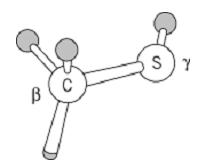


 النبات
النبات
 الحيوان
الحيوان
 الأحياء المجهرية
الأحياء المجهرية
 علم الأمراض
علم الأمراض
 التقانة الإحيائية
التقانة الإحيائية
 التقنية الحيوية المكروبية
التقنية الحيوية المكروبية
 التقنية الحياتية النانوية
التقنية الحياتية النانوية
 علم الأجنة
علم الأجنة
 الأحياء الجزيئي
الأحياء الجزيئي
 علم وظائف الأعضاء
علم وظائف الأعضاء
 الغدد
الغدد
 المضادات الحيوية
المضادات الحيوية|
Read More
Date: 28-10-2020
Date: 13-12-2015
Date: 20-5-2021
|
Cysteine (Cys, C(
The amino acid cysteine is incorporated into the nascent polypeptide chain during protein biosynthesis in response to two codons—UGU and UGC—and represents only 1.7% of the residues of the proteins that have been characterized. The cysteinyl residue incorporated has a mass of 103.15 Da, a van der Waals volume of 86 Å3, and an accessible surface area of 140 Å2. Cys residues are one of the most conserved type of residue during divergent evolution; they are interchanged in homologous proteins most frequently with serine residues.
The thiol group of the Cys side-chain

is the most reactive of any of the normal amino acids. It undergoes numerous chemical reactions with a variety of reagents. These reactions provide means for counting and measuring the number of Cys residues present in a protein (see Counting Residues and -Dithiobis-(2-Nitrobenzoic Acid), DTNB). It is the ionized thiolate anion that is reactive, and only it has absorbance in the UV region; the p Ka value of a typical exposed Cys thiol group is 8.7, but deviations as low as 3.5 and greater than 11 are known, depending on the environment (1).
In the nonionized form, the thiol group is not very polar or reactive, and thiol groups may be buried in folded proteins without the need for any hydrogen bonding. Approximately 40–50% of Cys residues are fully buried in folded protein structures. They occur predominantly in beta-sheet type of secondary structure. Cys residues can serve as efficient “capping” residues at the N-termini of a-helices in which their thiol group interacts with the hydrogen bonding groups of the backbone; the p Ka can then be decreased and the thiol groups made more reactive; probably for that reason, Cys residues occur at such positions in folded proteins only when important for function (2).
A notable tendency is for two Cys residues of the same or different polypeptide chains to form disulfide bonds. This occurs only if the protein conformation permits, and disulfide formation is a useful probe of protein folding in vitro. In vivo, disulfide bonds are usually inserted primarily into proteins to be secreted by the catalyst protein disulfide isomerase.
If a protein is hydrolyzed to amino acids under conditions in which the disulfide bond persists, two cysteine amino acids linked by a disulfide bond result, which historically was known as the amino acid cystine. Peptide bonds preceding Cys residues can be cleaved by cyanylation with 2-nitro-5-thiocyanobenzoic acid, followed by incubation at alkaline pH (3). The reaction is specific for Cys residues but has the disadvantage that the new N-terminus generated is blocked and not amenable to further sequencing by the Edman Degradation.
Thiol groups have intrinsic affinities for many metal ions, and they are used in proteins to ligate ions of zinc, iron, and copper. In an extreme example, metallothioneins about a third of the residues are Cys. The thiol groups of Cys residues are also used as nucleophiles in catalysis in the thiol proteinases.
Cys residues are the sites of several types of post-translational modifications, in addition to disulfide formation. Farnesyl groups and geranylgeranyl groups can be added to Cys residues at the C-termini of certain proteins, after removal of a few C-terminal residues. Palmitoyl groups can be attached in thioester linkages to the side chains of Cys residues.
References
1. J. W. Nelson and T. E. Creighton (1994) Biochemistry 33, 5974–5983.
2. T. Kortemme and T. E. Creighton (1995) J. Mol. Biol. 253, 799–812.
3. G. R. Stark (1977) Meth. Enzymol. 47, 129–132.



|
|
|
|
التوتر والسرطان.. علماء يحذرون من "صلة خطيرة"
|
|
|
|
|
|
|
مرآة السيارة: مدى دقة عكسها للصورة الصحيحة
|
|
|
|
|
|
|
نحو شراكة وطنية متكاملة.. الأمين العام للعتبة الحسينية يبحث مع وكيل وزارة الخارجية آفاق التعاون المؤسسي
|
|
|